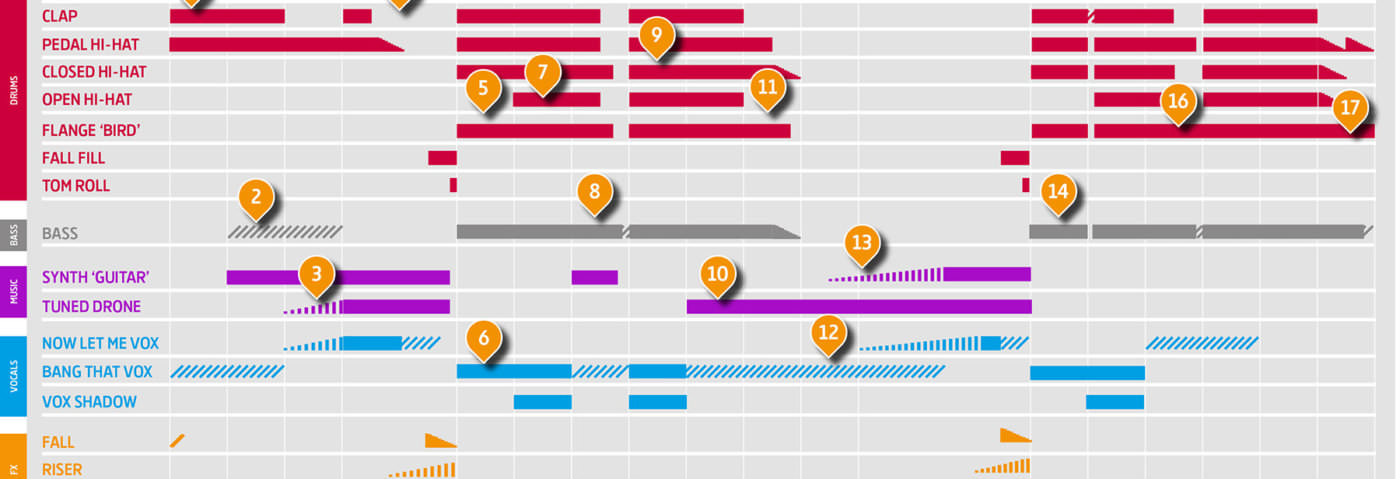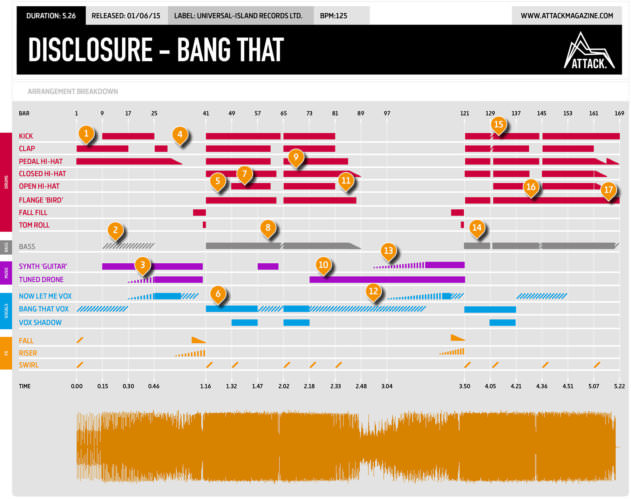We deconstruct the arrangements of tracks to see what we can learn from their structure.
It’s back to basics this month as we deconstruct Disclosure’s poppy take on ghettotech, ‘Bang That’.
The track
The arrangement
Click to enlarge.
What’s happening
1. A drum machine clap and an off-beat hi-hat open the track, both with lively room reverb. They supply a skeleton groove against which a pared-down version of the main “bang that” vocal part is overlaid, highlighting just the opening words of each line (“bang”, “shake”, “freak”, “work that”). The vocals, directly sampled from 313 Bass Mechanics’ ‘Pass Out’, move subtly around the stereo spectrum, with a tape delay effect adding echoes to the mix.
2. In comes the kick drum. The simple four-to-the-floor groove works against tuned bass hits right at the end of each bar – a simplified version of the bassline proper that will enter at bar 41. The upper frequencies are filled out by a single-note synth sequence evoking the sound (and rhythm) of a rhythm guitar.
3. A second synth enters – a rasping drone sidechained by the kick to give it rhythmic pull. At the same time, a filter opens over a new vocal part (“now let me see you bang it…” etc). Having two different lyrical sections allows Disclosure to shift between them, with the “now let me…” vocal playing during the builds and the main “bang that” vocal supplying the motif at the drops. Check last month’s deconstruction of Tessela’s ‘Hackney Parrot’, where the interplay between male and female vocal elements is critical to the track’s structure.
4. With the filter fully open on the “now let me” vocal, the kick drops from the mix, allowing the synth drone to rise free of its sidechain. Soon the clap and hats are cut too, with the pedal hat falling in volume to silence. It’s a classic breakdown technique: more and more parts exit the mix to pre-empt the drop a few bars down the line. At bar 33 it’s just the two melodic parts and the vocal sample left – which is now half-sized, old school-style (“now let me see y-“). A slowly building riser adds to the pressure, shortly joined by a falling FX. As the track moves towards the drop, the vocal’s reverb send is upped to swamp the mix with ambience. With the pressure at melting point, two fills are introduced: firstly a falling tom groove followed by a spritely ‘bass roll’ – a short sequence made using the same percussive bass sound as the bassline, but playing at the bottom of its natural register (and a fifth below the bassline root).
5. It’s the first drop, with nearly all rhythmic elements now in, the bass playing in full for the first time, and the main vocal motif mixed loud and proud. For what sounds like a pretty straightforward beat, there’s a lot going on. The kick, snare and pedal hat from earlier are now joined by a busier 909 closed hat line that lends an infectious energy to proceedings. Detail and depth is provided by a heavily flanged guiro or similar (we’ve called it ‘bird’) that provides ever-shifting tonal detail and movement to the groove.
6. The bass, another key driver in the deceptively simple groove, is built using tuned percussion – probably a drum machine tom sample. It bounces off the kick to keep the low end moving, with extra detail at turnarounds supplying fills.
7. In comes a third hi-hat – an open 909 sample layered over the existing pedal hat. Listen also for a kind of vocal ‘shadow’ that takes the word “pass”, pitch-shifts it, delays it, and fires it into a stereo-spread reverb to add a third dimension to the vocal. With tracks comprising so few elements, touches like this help keep the listener engaged.
8. The main vocal leaves the mix to be replaced by the same cut up “bang”, “shake”, “freak”, “work that” vox that opened the track. The synth part is back too. At bar 61, the 909 open hat quits the mix, leaving the closed hat and pedal, which are swiftly automated to silence. A bassline fill, allowed to shine alone, leads to bar 65.
9. After the brief strip-back of the previous few bars, the 8-bar 65-73 section is a repeat of bars 49-57. Although it’s relatively unusual to find entirely straight repeats, when your aim is pure party a certain amount of duplication may work in the track’s favour (over-fussy is not what this kind of dancefloor demands). In arrangement, context is all. And the context here is party.
10. Back comes the drone, sweeping between octaves. It will stay in the mix for a further 48 bars – supplying an ever-present melodic backing throughout the middle section of the track and a structural continuity to underpin the breakdown.
11. The kick, clap and open hi-hat quit the mix – here’s a chance to check the clever, slightly swung closed hat programming. Elsewhere, the drone continues droning and the EQ and reverb of the “bang… shake…” vocal cuts is automated to supply subtle tonal variations, the last two words blooming with ambience. Note the swift volume dips in both bass and hi-hats that take both parts into the drop – as well as the reverb added to the bass. These short, reverberated fade-outs are used throughout the track across multiple elements, making them something of a trademark production motif.
12. The breakdown proper begins, with just the drone and vocal cuts (still being automated) in the mix. At the tail end of bar 95, the guitar-style synth rises in volume to reinforce the rough rhythm of the cut-up vocal.
13. Echoing the entry of the vocal way back at bar 17, the “now let me” vox cut reappears, with the same ascending filter cutoff to up the pressure. It’s one of the oldest tricks in the book, but it’s always effective. Other tricks from the first build – rising FX, fall, the twin fills – are all rolled out a second time for the main breakdown. Two things are different this time around. Firstly the length. The main breakdown lasts 64 bars (just over a minute), contrasted with the 8-bar build at bar 33. Secondly, the twin drone and guitar-style synths are pushed further forward in the mix, with the drone’s modulation automated to provide some subtle ’80s-style warbles
14. The sudden loss of drone and ‘guitar’ makes the contrast between breakdown and drop absolute. Instantly the mix feels clearer – and full of power. The drop is about re-asserting the importance of the track’s key elements – in this case, the bass, beat and lead “bang that” vocal.
15. Bar 129 opens with a two-bar edit to the kick/clap and bass. The programming may be basic, but its effect is to provide a refreshing ‘stumble’ in the established rhythm – a nice detail. The open hi-hat re-enters, following the same structural pattern as laid down across bars 41-57.
16. The remainder of the track is about winding down the energy one step at a time. Bars 137-145 are a direct repeat of bars 57-65 – though notably without the synth this time.
17. There’s no messing with extended DJ play outs here. Instead, Disclosure get the job done in the space of a single eight-bar section, with all three hi-hat parts quitting the mix before a return of the pedal hat. The last four bars see a low-pass filter set to work on the kick drum to take the track to the finish line – a last instance of the flanged ‘bird’ shooting a short halo of detail into the silence.


04.17 PM
Why on earth would you feature this commercial claptrap?
06.59 PM
Shit track. Why are you writing about this mainstream crap!?
12.32 AM
it’s helpful to see the breakdowns, regardless of what you consider the track quality to be. you can always learn something from it.
11.54 AM
Well I like the track and the decontruction 🙂 I hope next time their will be again a track decontructed without vocals
09.25 PM
As someone who loves undergrounds music, I really don’t see why there is so much hate for Disclosure. They write hooky, energetic dance music that has broad appeal that sounds way closer to classic dance music than most popular EDM.
Good breakdown, too. Thanks for this Attack
03.49 AM
great work! very helpful
11.06 AM
Good track, this works for me!
10.01 PM
Not sure why the hate on this track, either. These guys know how to get it done. Commercial or not, this track is on point.
Thanks for the deconstruction. Loved it!
11.00 PM
Very helpful and well explained. Thank you!
03.50 AM
Laughable that there are haters on this record. It is solid in the underground, and mainstream settings. Quality is quality, and good production is good production at the end of the day. Good stuff!